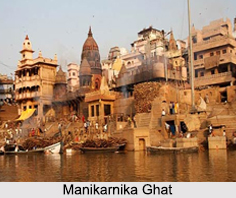 Known to be one of the holiest ghats of Varanasi, the Manikarnika Ghat is named after the Rani of Jhansi, Lakshmi Bai who was born here. The ghat is flanked by the Dashashwamedh Ghat and the Scindia Ghat. Near the ghat there is also a sacred well called the Manikarnika Kund, which is said to be built by Lord Vishnu.
Known to be one of the holiest ghats of Varanasi, the Manikarnika Ghat is named after the Rani of Jhansi, Lakshmi Bai who was born here. The ghat is flanked by the Dashashwamedh Ghat and the Scindia Ghat. Near the ghat there is also a sacred well called the Manikarnika Kund, which is said to be built by Lord Vishnu.
History of Manikarnika Ghat
The Manikarnika Ghat is one of the oldest ghats in Varanasi and is revered in Hindu religion. There are even mentions of the ghat in a Gupta inscription of 5th century. Near the ghat, there is Manikarnika shrine, which is an important place of worship in the Shaktism sect of Hinduism. It is one of the Shakti Peethas, where one of Sati Devi"s earrings fell off. The Shakti of Manikarnika is addressed as Vishalakshi & Manikarni.
Myth behind Manikarnika Ghat
In Sanskrit, Manikarnika means earrings, the word mani means jewel or beads and karnam means ear ornament. According to texts from Hindu mythology, it was here in Varanasi erstwhile Kashi that Lord Vishnu meditated for several thousand years and prayed to Lord Shiva to not destroy the holy city Kashi. Lord Shiva and Goddess Parvati came down to Kashi and granted his wish, and in reverence Lord Vishnu dug a kund or well on the banks of the Ganga River for the divine couple to bath. When Goddess Parvati was bathing in the kund, she lost an earring, which fell into the well and the name Manikarnika Kund came around.
Significance of Manikarnika Ghat
The city of Varanasi is said to be one of the holiest cities in both Jainism and Hinduism and the Manikarnika Ghat is one of the main burning ghat in the city. As per Hindu beliefs, it is known that death is a gateway to another life and the soul of a deceased human attains moksha, when they are cremated at this ghat.
Manikarnika Ghat in Art
The Manikarnika Ghat has also been put into various arts by famous artists and painters from all around the world. In Edwin Lord Weeks" painting The Last Voyage, 1884, the Manikarnika Ghat is represented in an oil painting. Other popular depictions of the ghat are in Edward Lear"s Cityscape, 1873, James Prinsep"s Eve of the Eclipse of the Moon and in J. Peddar"s Picturesque India: A handbook for European travellers, 1890.



















